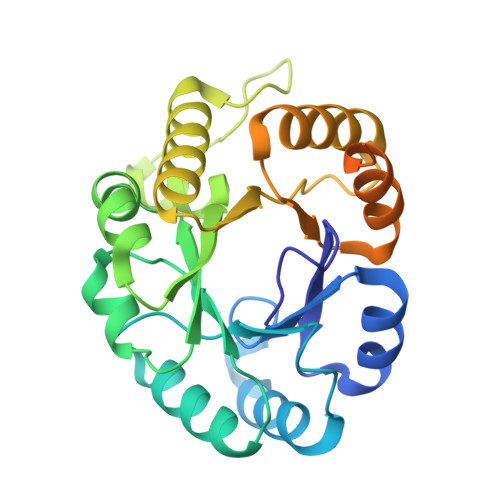The structure and computational analysis of Mycobacterium tuberculosis protein CitE suggest a novel enzymatic function.
Goulding, C.W., Bowers, P.M., Segelke, B., Lekin, T., Kim, C.Y., Terwilliger, T.C., Eisenberg, D.(2007) J Mol Biology 365: 275-283
- PubMed: 17064730
- DOI: https://doi.org/10.1016/j.jmb.2006.09.086
- Primary Citation of Related Structures:
1U5H, 1Z6K - PubMed Abstract:
Fatty acid biosynthesis is essential for the survival of Mycobacterium tuberculosis and acetyl-coenzyme A (acetyl-CoA) is an essential precursor in this pathway. We have determined the 3-D crystal structure of M. tuberculosis citrate lyase beta-subunit (CitE), which as annotated should cleave protein bound citryl-CoA to oxaloacetate and a protein-bound CoA derivative. The CitE structure has the (beta/alpha)(8) TIM barrel fold with an additional alpha-helix, and is trimeric. We have determined the ternary complex bound with oxaloacetate and magnesium, revealing some of the conserved residues involved in catalysis. While the bacterial citrate lyase is a complex with three subunits, the M. tuberculosis genome does not contain the alpha and gamma subunits of this complex, implying that M. tuberculosis CitE acts differently from other bacterial CitE proteins. The analysis of gene clusters containing the CitE protein from 168 fully sequenced organisms has led us to identify a grouping of functionally related genes preserved in M. tuberculosis, Rattus norvegicus, Homo sapiens, and Mus musculus. We propose a novel enzymatic function for M. tuberculosis CitE in fatty acid biosynthesis that is analogous to bacterial citrate lyase but producing acetyl-CoA rather than a protein-bound CoA derivative.
- Institute for Genomics and Proteomics, UCLA, Los Angeles, CA 90095-1570, USA.
Organizational Affiliation:

















